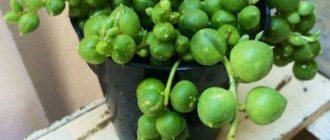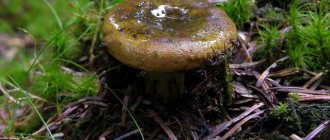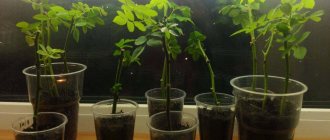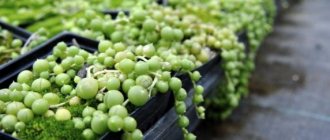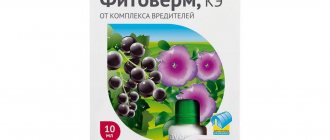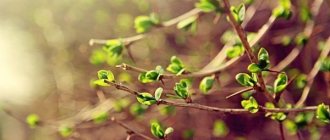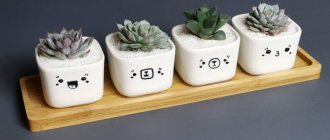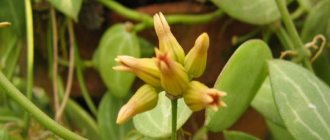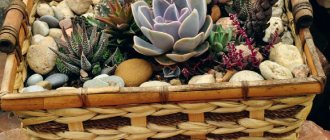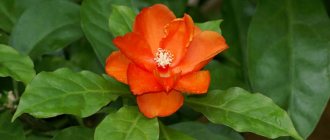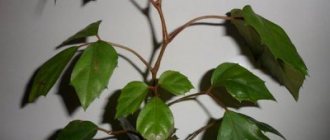Popular domestic species
Each of the existing species fascinates with something unique to it. This could be the unusual shape of the succulent leaf, the fluffiness of the stem, the size of the flower basket, or the color palette. What unites such different plants is the same type of inflorescences. Regardless of the size, the formations (one or many) are always represented by a basket, with the ability to gather into scutes or panicles.
Representatives of indoor keeping are represented by twenty different species of succulents. Among them there are popular and little-known individuals. The individuals are so different in appearance, but so similar in their care requirements.
Rowley (Senecio rowleyanus)
The perennial, the most common indoor plant, is distinguished by its growth intensity. Long shoots with thin threads can hang in a hanging arrangement, or spread along the ground, covering an impressive surface. They are spherical, centimeter-sized at the base and tapering to a sharp tip, arranged like beads on a string. White flowers with prominent purple pistils are collected in basket-shaped inflorescences. During flowering, the smell of cinnamon spreads.
Rowley's ragwort/blooming
Large tongue (Senecio macroglossus)
This representative has the structure of a vine, and at first glance resembles the common singing one. A distinctive feature is denser and larger leaves on long stems (up to three meters), weakly branched and woody. The copy-shaped leaf blades are arranged densely with the help of small petioles and are attached to the stem.
Flowering occurs in winter, collected in apical or axillary baskets (usually single, spherical in the center), with small yellow flowers. In the basic version, variegated varieties with stripes or spots of white and yellow shades are of increased interest.
Ragwort / flowering
Stapeliiformis (Senecio stapeliiformis)
A herbaceous perennial, a worthy specimen of the succulent genus, resembling a cactus in appearance. Erect shoots are fleshy, have pronounced edges, and are subject to branching from the very bottom.
The modified leaves are represented by needles located along the trunk, from the very bottom to the top, in straight rows along the stem edges. The waxy coating gives the plant a green, silvery color. Collected from flowers (from orange to pink to bright red tones), baskets of inflorescences look like a carnation flower.
Ragwort stapeliiformes / flowering
Lemon (Senecio citriformis)
Perennial, reaching half a meter. The berry leaves look like mini lemons and limes. The color is a thick gray-green tone. There is a bluish coating. The inflorescences are like chamomile, creamy yellow in color.
Lemon-shaped ragwort
Large tongue
Large-tongued groundsel - False ivy - Seneciomacroglossus.
Leaf succulent is a long-lived plant with creeping stems. The shoots can reach 1.5-3 m in length, branch slightly and slowly become woody.
The silhouette of the leaf blades follows the outlines of the spearhead and the leaves of true ivy. The inflorescences are on a long peduncle, very similar to field daisies. They have a yellow fuzzy center and light petals around them.
The variety Variegatus is distinguished by its two-colored leaves. Their dark green surface is painted with contrasting straw or smoky spots of arbitrary shape and location.
Care
The maintenance of succulent species differs from the care of herbaceous representatives, but not much, and not in many ways. The key to successful cultivation are quite simple rules for supplying moisture, light, maintaining comfortable temperatures, and moderate fertilizing. It is easier to maintain a certain regime at home than in the open ground. Let's take a closer look at the main points of care.
Watering
Ragwort is one of the most sensitive succulent representatives to excess soil moisture. Floods and abundant moisture are strictly contraindicated for it. Regardless of the season of the year, you should adhere to the rule: less is better, but more often.
A small volume of water for irrigation better saturates the earthen ball, without leaving excess in the soil. The frequency of moistening depends on the drying of the upper soil layer. Strict control of the condition of the substrate introduces a little complexity into care (the difficulties are basically limited to this).
In the warm seasons of the year, watering is carried out a couple of days after the onset of surface dryness of the soil. The beginning of autumn brings changes to the maintenance regime. Regardless of weather conditions, the flower is gradually preparing for a period of rest (or it should be prepared artificially).
During adaptation, it is worth increasing the gap between waterings, gradually bringing the earthen clod to complete drying from one moistening to the next. In winter, if the leaves remain elastic and there are no signs of moisture deficiency, you can not water the plant. The water used is soft and kept for a long time at room temperature.
Lighting
The eastern or western sides are well suited for permanent habitat. Morning and evening direct sunlight will not harm the plant; on the contrary, their exposure has a very beneficial effect on the richness of the color and the uniform growth of shoots.
“Living” on southern windows requires the presence of scattering of the daytime messengers of the heavenly body (unlike their morning and evening counterparts, they can destroy a pet).
The lack of bright lighting manifests itself in stretching of internodes and stems. Variegated species lose their individuality in color, which leads to a loss of external attractiveness.
Temperature
The ideal temperature regime for Raspberry is the time division between spring-summer and autumn-winter. This is due to the presence of periods of activity and a state of rest in the life cycle. The warm season is characterized by elevated temperatures (about twenty-two degrees plus, and the permissible range is twenty-six). Succulent pets have a negative attitude towards sudden temperature changes, but prefer access to fresh air in the form of ventilation.
This feature allows you to “walk your green friend” with external thermal data equal to indoor conditions (summer season). In cold weather, you should lower the temperature by ten degrees. The impossibility of carrying out such regime adjustments is replaced by additional lighting (at least 10 hours of daylight) and low-volume watering as necessary. Senecio are capable of adapting to a specific home range.
Humidity
This creation of the plant world is perfect for living in the microclimate of city apartments. Even during periods of increased central heating operation. Of course, it is worth protecting the “tenant” from directed flows of heated air. Aversion to high humidity eliminates the need for additional humidification of the plant and the surrounding air through regular spraying and spraying of water.
The soil
The main requirement for soil composition is good drainage properties. Along the way, you should take into account the acidity (preferably neutral), the saturation of substances for plant nutrition. Ready-made soil (from a flower shop) is suitable for succulents and cacti, with the addition of coarse river sand or perlite.
It is possible to mix the substrate yourself. For it you will need sheet soil (two parts) and the same sand (one part). You can add orchid substrate (in a crushed state) to the prepared soil in a one to one ratio. Some species are able to successfully exist in mixed sandy-clayey soils. It is important to consider the soil in which young specimens were grown. Habituation is a dominant factor in soil selection.
Transfer
The replanting process for Senecio is carried out depending on the need of the enterprise. The depth level in the new pot remains the same as before. The bottom of the container is lined with a fairly thick layer of expanded clay (which protects the roots of the plant from possible rotting due to good drainage properties).
The spring period is most optimal for carrying out this work. Young crops, due to the intensity of development, require more frequent changes of containers and earthen substrate. A transplant once a year is acceptable for them. Adult plants are content to carry out this process at intervals of two or three years.
Both ordinary flowerpots and hanging structures are suitable for the Krestovniks’ “living”. When growing in canopies, several (from five) shoots should be placed together in one vessel. In this way, it will be possible to form a “waterfall of greenery,” because by nature, individuals are weakly branched.
Fertilizer
The ward will have to be fed during the period of active growth, and it falls on the spring-summer time interval (from the first spring month and including the last summer month). The frequency of fertilization is one application every fourteen days. In some cases, it is permissible to increase the interval to 21 days or a month. Among ready-made fertilizers, you should choose ones with a reduced concentration of the nitrogen component. These include cactus, succulent, and orchid varieties of produced fertilizers for representatives of plant diversity.
The soil
The easiest way is to use ready-made soil mixtures made for cacti and succulents. If it is not possible to buy a ready-made substrate, you need to select a loose, moderately nutritious and acid-neutral soil. It can be a mixture of leaf soil and coarse sand (2:1); some specimens grow better in a sandy-clay substrate. Much depends on what the plant is used to, therefore, when purchasing an already grown specimen of a flower in a pot, you should pay attention to what it grew in, or ask the seller about the composition of the soil.
Reproduction
You can get new specimens from the individuals you like in three ways: through sowing seeds, cuttings of apical shoots, layering from creeping and penetrating species. Each of these methods is interesting in its own way.
- Seeds
It is used extremely rarely due to the small number of succulents bearing fruit in indoor conditions. Only fresh seed is used. Pre-sprouted, several copies are sown in one vessel. Humidification is carried out using a spray bottle. When the cotyledons appear, they are planted in individual containers with a diameter of five centimeters.
- Cuttings
Quite a simple way. Root formation takes place without additional effort and time. The upper part of the shoot (about 10 centimeters) should be deprived of the lower pair, three leaves, and dried for some time. It is necessary to plant in individual pots, in sandy soil without moisture, with light spraying.
Having formed roots, individuals are transplanted in groups of two or more into one vessel to create a lush and attractive appearance. For some species, simple laying on the soil surface can be used (for example, Rowley's ragus). Roots emerge from the stem nodes quite quickly.
- By layering
It is difficult to imagine a more unpretentious breeding option. Long creeping or drooping stems are placed in a bowl filled with soil for the succulent placed next to the mother plant. Parts of the shoots pressed to the soil begin to develop their own root system. The rooted lashes are carefully separated from the “mother”.
- Additionally
There are species that produce a new representative through the rooting of a leaf cutting. But due to its length and low success rate, the process is rarely used to obtain a new instance.
Growing ragwort from seeds
Ragwort seeds Senecio photo
Annual species of ragwort are mainly propagated in this way:
- Take regular potting soil and add some vermiculite and fill a seedling container with a clear lid.
- Plant the seeds to a depth of their own size (as little as possible), place the container under diffused lighting and maintain the temperature within 22-25 °C, spray the soil with a fine sprayer as necessary.
- When the first shoots appear, remove the lid.
- After forming a pair of true leaves, plant them in separate pots with a diameter of 5-7 cm.
To make the senecio bush grow lush, plant several sprouts in one pot (this applies to species with drooping shoots).
Diseases and pests
Succulent crops are very resistant to diseases and pests that are common when kept at home. Most often, flower health problems occur due to violation of care conditions.
Diseases
- Powdery mildew – excess nitrogen in the soil. Removal of damaged parts, treatment with Fundazol solution (one gram per liter).
- Gray rot is a violation of the rules of care (poor light, waterlogging, cold). Restore the required conditions. Treat with copper oxychloride.
Leaf damage
- Brown spots, drying out, falling off - lack of normal soil moisture, dry air, greatly increased ambient temperature.
- Dry areas on the surface are sunburn.
- Yellow and brown spotted rashes on the plates indicate an excess of water in the ground.
- Scanty, sparse and small foliage means lack of light.
- Variegated colors turn into monochromatic colors - low light, or a cramped pot.
Pests
- Greenhouse pelargonium aphid - destroys young shoots and inflorescences. Requires high humidity, critical treatment with insecticides.
- Spider mite - spoils foliage. Maintaining high moisture content in the air, warm shower. In its peak form, Actellik is used.
- Mealybugs - suck out juices. Soap or alcohol solution, in extreme cases, Karbofos emulsion.
Transfer
Actively growing young specimens require transplantation annually. Starting from the 3rd year of life, they need to be replanted only as needed. It is recommended to do this in the spring, when the plant is preparing or just starting to wake up. A fairly high drainage layer is poured into the bottom of the new dish (higher than for ordinary plants). When replanting, it is necessary to monitor the position of the root collar; its level must be maintained; deepening is unacceptable. Transplantation is carried out by transshipment with minimal damage to the root system.
Species grown in open ground
Garden varieties require well-lit places with diffused sunlight, fertile soils with good drainage. Otherwise, you will have to save the plants from burns and drying out, fight root rot and decay of the lower ground parts of the flowers.
Ashy (meadow) (Senecio praticola)
Perennial up to half a meter. Straight stems, when young, pubescent with a loose cobwebby type. The leaves are rosette, differently shaped (depending on location). Umbrella inflorescences consist of a maximum of 9 baskets. The flowers are yellow, ligulate.
Seaside (Cineraria maritima)
An evergreen subshrub or shrub. Cultivated as an annual (although perennial). The surface of the leaves is covered with silvery hair. Inflorescences are removed when they appear due to their low decorative value. Requires full lighting.
Coastal ragwort
Bloody (Senecio cruentus)
The annual Cineraria Bloody rises 0.6 meters. The soft, fluffy leaves are two-colored: dark green on top, red underneath. The flowers are shaped like primroses and daisies. Inflorescences of reed baskets are collected in lush brushes. Wide range of colors.
Bloody ragwort
Mixed (Senecio confusus)
Perennial liana. Curly lashes up to three meters. The foliage is dark green, heart-shaped, and veined. Small flower clusters of bright orange heads. Gradually turn red.
Yakova (Lugovoi) (Senecio jacobaea)
It grows as a perennial or biennial plant. The stem of this herbaceous representative is erect, with edges and grooves, and ranges in height from ⅕ part to a full meter. The leaves change shape and attachment to the trunk as they move upward. General characteristic feature: the leaves are represented by lyre-shaped pinnate cuts along an oblong ovoid plate. Upper inflorescences of false ligulate flowers of pale or bright yellow shades are collected by a large number of baskets into corymbose panicles.
Biological description
All godsons are classified as succulents, i.e. plants capable of heating up moisture reserves and living off them in depleted growing conditions. The species diversity of senecio is enormous, including coniferous greens, pea-like greens, and climbing ones like ivy. Their shoots can grow like vines, or they can form bushes and even trees. Moreover, they can be pubescent and bare, erect and drooping, and the shape of the leaves of this group of plants makes it almost impossible to cover. In nature, there are more than 3000 of them. And they all have only one thing in common - the classic inflorescence-basket.
Senecio is grown both as a potted and garden crop. There are species that are intended for cutting. From ragworts alone you can create a rich collection of succulents, which will be very diverse.
